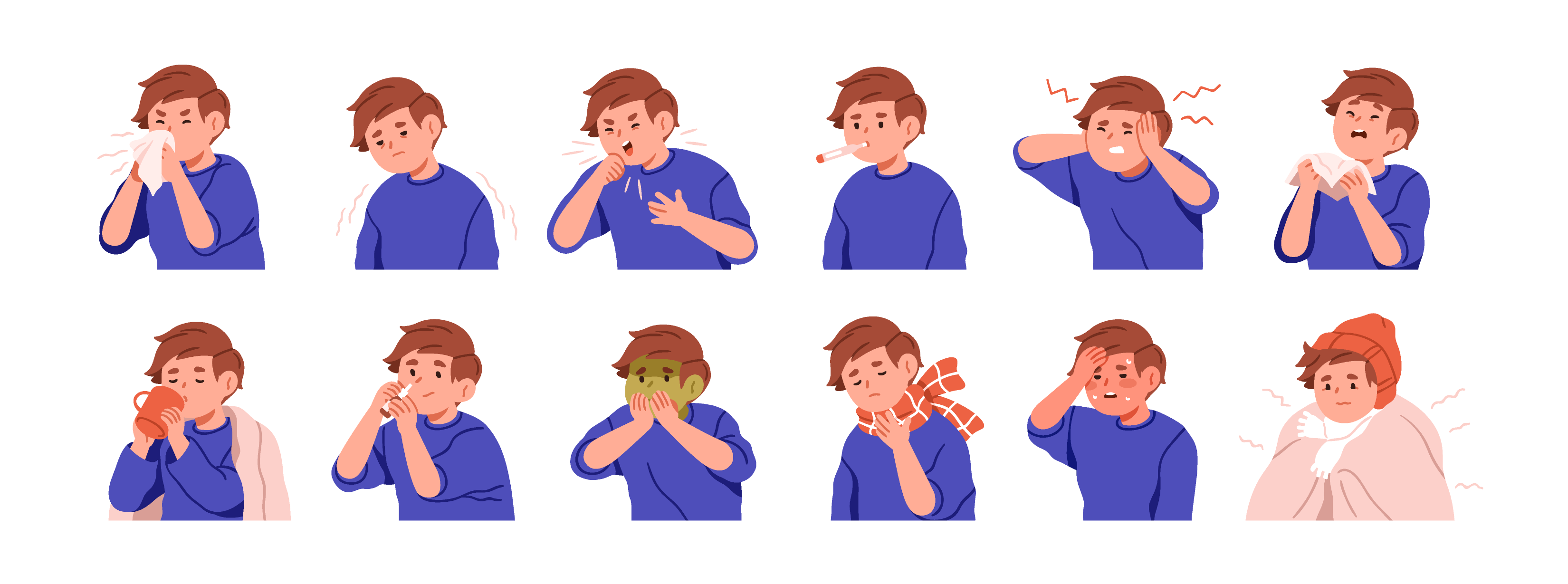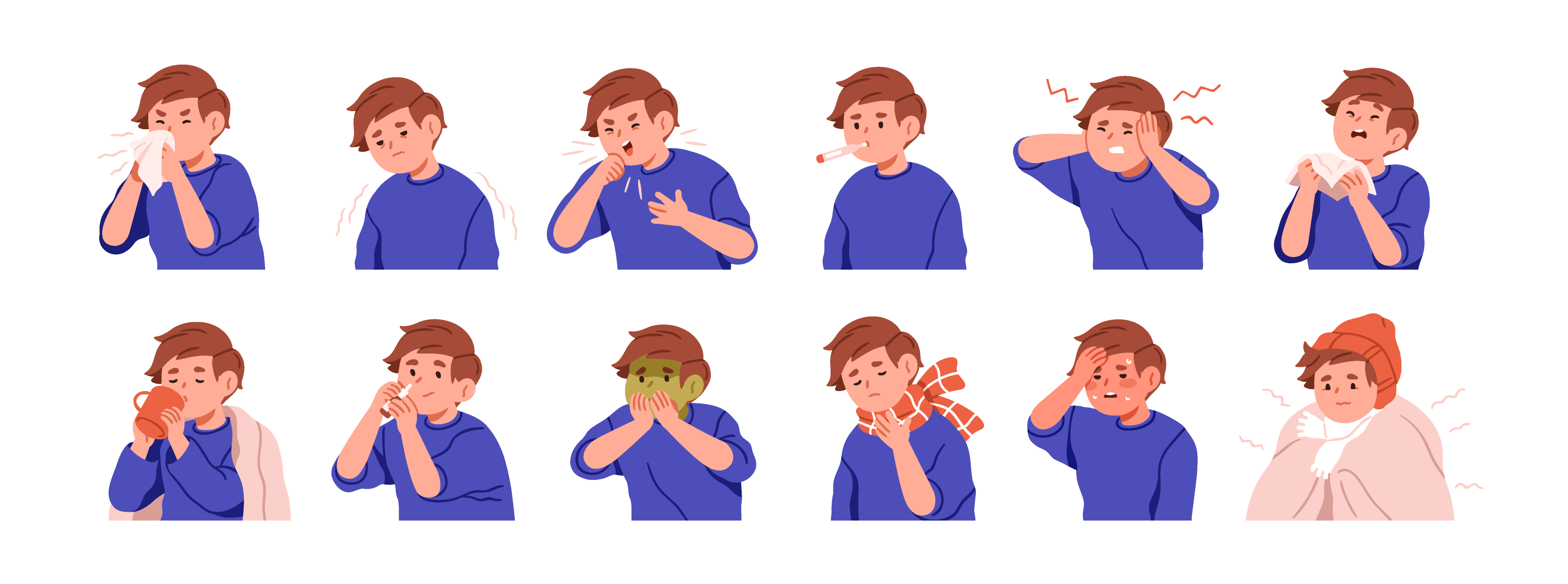

Finally, winter is here, and so is the season of coughing, sneezing, and sniffling. But did you know scientists have discovered why respiratory infections are more common during winter? Yes, a recent study in The Journal of Allergy and Clinical Immunology states that reducing the temperature inside the nose by as little as 5℃ kills nearly 50% of the virus and bacteria-fighting cells. Not only this, but the winter season is also responsible for aggravating some severe respiratory diseases, like asthma, chronic obstructive pulmonary disease (COPD), etc.
So let us look at some common and severe respiratory illnesses during winter and ways to manage them.
1. Common cold
Although winter lets you enjoy curling up in front of the fire and sipping your cup of hot coffee, it also brings a tale of woes: the common cold. The common cold is something nearly everyone experiences. Its symptoms include congestion, sore throat, sneezing, runny or stuffy nose, and cough. You would be surprised to know that there are more than 200 different viruses that can cause the common cold, with rhinovirus being the most common.
Tips for managing a common cold:
-Rest, eat home-cooked food, and drink ample fluids.
-Sucking a throat lozenge may help to relieve a sore throat.
-Cool mist humidifiers can help keep the nasal secretions liquid, clear a stuffy nose, and help you breathe well.
-Zinc supplements (administered within 24 hours of symptom onset) may help reduce the duration of the symptoms.
-Take medicines for congestion and cough as prescribed by your doctor.
Get Rid Of Chest Congestion And Sore Throat With These Best Selling Respiratory Care Products
2. Flu
If you have the symptoms of the common cold along with fever, headache, tiredness, body pain, nausea, or vomiting, you are more likely to be affected by the flu. Three types of viruses cause flu: Influenza A, B, and C.
Tips for managing flu:
-Cover your mouth and nose when coughing or sneezing, wear a face mask, and follow good hand-washing practices to prevent the infection from spreading.
-Take vitamin C supplements and herbal formulations to improve your immunity.
-Drink warm beverages, take steamy baths, and use a cool air humidifier to help open your airways and ease breathing.
3. Sinusitis
Sinusitis is the inflammation of the spaces around the nasal passages, known as the sinuses. In case of a cold, the sinuses get blocked and filled with mucus. When this happens, bacteria can grow and cause an infection. Symptoms of this illness include a runny or blocked nose and severe headache.
Tips for managing sinusitis:
-Using warm compression over the nose and forehead may help reduce sinus pressure and relieve the headache.
-Use a saline nasal spray to relieve a blocked nose.
-Use steam or nasal inhalers. You may also add a few drops of essential oil to a bowl of hot water for steam inhalation.
Troubled By Sinuses? Try These Effective Products To Help Ease Your Symptoms
4. Bronchiolitis
Bronchiolitis is a common lung infection that affects infants under the age of two. It happens when tiny airways called bronchioles to get infected by a virus (syncytial virus) and is more common during winter. The signs and symptoms of bronchiolitis are similar to those of a cold but may progress to severe coughing, wheezing, and sometimes breathing difficulties. Most babies with minor symptoms get better with proper care at home, but if your child faces breathing difficulties, has a high-grade fever, or their lips or nails have turned blue, consult a pediatrician immediately.
Tips for managing bronchiolitis:
-Avoid contact of your baby with other people since the virus is contagious.
-Offer frequent breastfeeding/formula feeding to keep your baby hydrated.
-Using a cool air humidifier gives relief from cough and congestion and loosens mucus.
-Frequent surface cleaning of the house should be done to keep germs at bay.
-Your doctor may also recommend nebulization to your child to ease breathing.
5. Bronchitis
Bronchitis is also a lung infection that can affect people of any age. It happens when the airways of your lungs, called bronchi, get inflamed and fill with excess mucus, leading to a cough. This can occur due to a virus or other lung irritants such as smoke, cigarette smoking, or a history of COPD.
Tips for managing bronchitis:
-Use steam inhalers to loosen the mucus and to help you breathe better.
-Frequent gargling with saline water may help reduce mucus and throat pain.
-Take vitamin D supplements, get adequate rest, and avoid smoking.
6. Pneumonia
Pneumonia is an infection of one or both lungs caused by bacteria, viruses, or fungi. It is a condition in which the lungs get filled with pus and fluid, making breathing difficult and limiting oxygen intake. Although pneumonia can affect people of any age, it is most serious in infants and children, elderly people (over 65 years), and those with underlying health problems or a weak immune system. People at a high risk of pneumonia should be given pneumococcal and flu vaccines. Mild cases of pneumonia can be treated at home with rest and antibiotics (if it is caused by bacterial infection), whereas severe cases may need hospitalization.
Tips for managing pneumonia:
-Make sure to get enough rest while recovering from pneumonia.
-Drink plenty of fluids to keep your body hydrated and reduce congestion.
-Take vitamin C and zinc supplements to help strengthen your immune system.
7. Asthma
Asthma is a chronic condition that affects the airways in your lungs. The airways and the muscles around it become inflamed when exposed to a trigger (dust, mites, or pollen). This results in symptoms like coughing, wheezing, breathlessness, and chest tightness. But asthma symptoms worsen in winter as the dry airways become irritated and swollen. Also, during winter, the body produces thicker and more sticky mucus than normal. This extra mucus production tends to attract infection and aggravate asthma symptoms.
Tips for managing asthma:
-Limit exposure to triggers, such as dust, pets, pollens, etc. If necessary, use a mask to protect yourself.
-Avoid certain foods that may trigger an asthma attack.
-Avoid exercising outdoors during winter since the air is cold and dry.
-Carry a reliever inhaler at all times for sudden attacks.
-Practice deep breathing exercises to relax your airways and resume normal breathing. Always consult your doctor before doing any kind of exercise.
-The doctor may prescribe long-term medicines to help decrease the frequency of sudden attacks.
Don’t Let The Worsening Pollution Affect Your Lungs Anymore. Get The Right Mask To Suit Your Needs
8. Chronic obstructive pulmonary disease (COPD)
COPD is a group of lung diseases that block airflow and interfere with normal breathing. Symptoms of COPD range from cough and difficulty in breathing to wheezing.
Tips for managing COPD:
-Quit smoking to prevent COPD from worsening.
-Try to avoid secondhand smoke, air pollution, dust, and chemical fumes that can worsen your breathing.
-Steam inhalation removes the mucus from the air passages and improves breathing.
-Your doctor may recommend steroid-based and bronchodilator medicines to avoid advancing the disease.
These simple tips can help you manage various respiratory illnesses during winter. However, if you fail to show any improvement in your condition or your symptoms worsen, do consult your doctor. It is strictly advised not to self-medicate, as doing so can worsen the condition. Also, follow your doctor’s instructions, take medicines on time and complete the course.
(The article is written by Monalisa Deka, Senior Health Content Editor and reviewed by Dr. Rajeev Sharma, Vice President (Medical Affairs))
Recommended Reads:
Respiratory Infections Found To Increase Chances Of Heart Attack
Respiratory Allergies And Asthma: All You Need To Know!
References
1. Huang, D., Taja, M. S., Nocera, A. L., et al. (2022). Cold exposure impairs extracellular vesicle swarm-mediated nasal antiviral immunity. The Journal of Allergy and Clinical Immunology (online) Available at: https://www.jacionline.org/article/S0091-6749(22)01423-3/fulltext
2. Dasaraju PV and Liu C. Infections of the Respiratory System. Medical Microbiology. 4th edition. (online) Available at: https://www.ncbi.nlm.nih.gov/books/NBK8142/
3. NHS. Flu. (online) Available at: https://www.nhs.uk/conditions/flu/
4. Centers for Disease Control and Prevention. Healthy Habits to Help Protect Against Flu. (online) Available at: https://www.cdc.gov/flu/prevent/actions-prevent-flu.htm
5. Mayoclinic. Bronchiolitis. 2022. (online) Available at: https://www.mayoclinic.org/diseases-conditions/bronchiolitis/symptoms-causes/syc-20351565
6. NIH. NHLBI. Bronchitis. 2022. (online) Available at: https://www.nhlbi.nih.gov/health/bronchitis
7. NHS. Pneumonia. 2022. (online) Available at: https://www.nhs.uk/conditions/pneumonia/
8. NHS. Sinusitis. 2022. (online) Available at: https://www.nhsinform.scot/illnesses-and-conditions/ears-nose-and-throat/sinusitis
9. NHS. Chronic obstructive pulmonary disease (COPD). 2022. (online) Available at: https://www.nhs.uk/conditions/chronic-obstructive-pulmonary-disease-copd/
10. American Lung Association. Managing Asthma. 2022. (online) Available at: https://www.lung.org/lung-health-diseases/lung-disease-lookup/asthma/managing-asthma